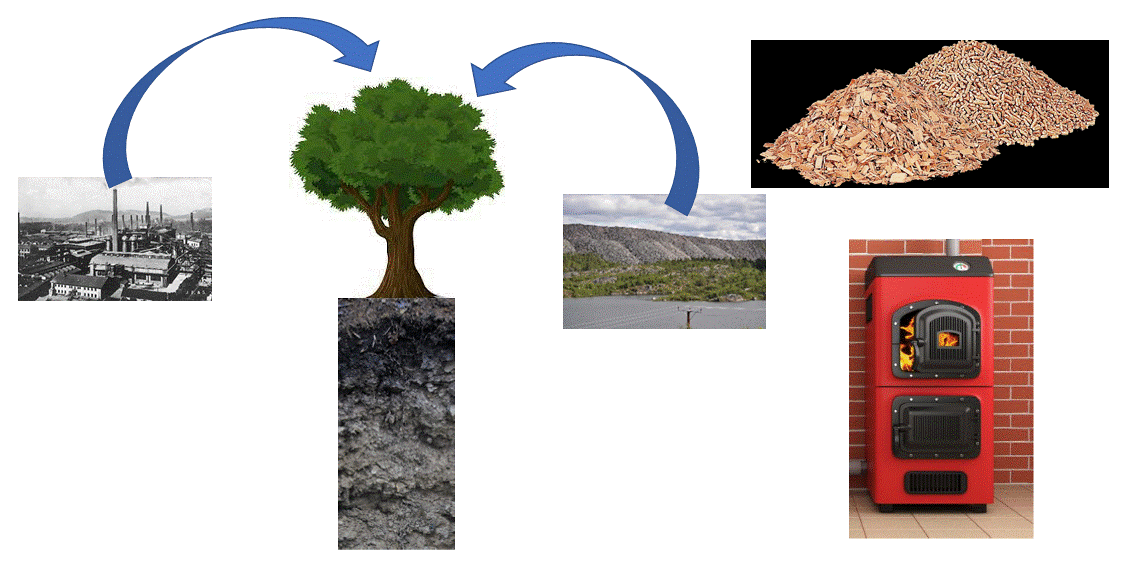As one of the alternative fuels to coal, biomass has a CO2 emissions balance of almost zero. Currently, biomass accounts for a significant share of renewable energy sources in Europe (about 50%), although the burning of biomass has recently become subject to environmental regulations in some countries. Recent studies have shown that biomass combustion emits significant amounts of dust and organic compounds into the air. In Poland, biomass is mostly burned in low-power boilers for heating single-family houses or in small boiler houses without dust collection systems. Its share is considerable, especially outside the normal heating season, particularly in tourist and holiday areas where wood is much more readily available than coal. Together with the fly ash released into the atmosphere when coal is burned, many harmful chemical substances are released into the environment. One of these is potentially toxic metals and metalloids, which are transported mainly by technogenic magnetic particles (TMPs - mainly iron oxides) produced during combustion. Due to the magnetic properties of TMPs, their presence in the environment can be easily detected by simple measurements of magnetic parameters. In coal, iron occurs in mineral forms (mainly sulphides) with paramagnetic properties, and during combustion Fe is converted into oxide forms that have mainly ferrimagnetic properties, which is why the ash after coal combustion is "magnetically enriched" compared to the original fuel. Biomass consists mainly of organic material with diamagnetic properties, and the iron contained in plants is mainly in the form of organic compounds (e.g. organometallic complexes, phytoferritin, chelates), so the expected iron oxide content in the ash should be much lower. However, preliminary measurements of the magnetic susceptibility of the fly ash after burning different types of biomass have shown that the magnetic properties of the ash were surprisingly high and very differentiated depending on the type of biomass burnt. There is a high probability that other magnetic parameters also vary and are therefore characteristic of individual types of biomass and can be used as indicators of the type of burnt biomass determined in the ash samples. The second aspect of the research will be to determine to what extent the environment in which the biomass grows (i.e. the geological background, the soil type and the degree of soil contamination, the degree of atmospheric deposition during plant growth) influences the content of trace elements and magnetic particles in bottom and fly ash after biomass combustion. This is particularly important as in many places biomass is produced from areas that are excluded from food production due to high levels of soil contamination, or even old mining and smelting dumps are used for biomass production. The question thus arises as to how environmental conditions and the degree of pollution affect the magnetic and chemical properties of both the fine fly ash particles released into the atmosphere and the bottom ash increasingly used for soil fertilisation. The aim of the study is to compare bottom ash and fly ash after combustion of 6 selected types of biomass and to determine chemical substances and magnetic parameters that may be characteristic indicators of each type of biomass combustion. The second objective is to determine the influence of the geochemical and geological background and other environmental factors (e.g. air pollution, soil type, soil contamination) on the ecological quality of biomass and the content of potentially toxic elements (PTEs) in bottom and fly ashes. The research is conducted on samples of 6 different types of biomass in the form of pellets available on the market, as well as on samples of wood biomass obtained from four different sites: From forested old metallurgical and mining dumps, from areas with natural magnetic anomalies formed on magnetite-rich natural igneous or metamorphic rocks, from heavily polluted areas formed on sandy soils, and from "ecologically clean" areas with low deposition and diamagnetic geological background. Biomass combustion is carried out in a low-power boiler suitable for biomass combustion and often used in heating systems. This boiler is equipped with analysers and control sensors that allow monitoring and control of the combustion conditions. Samples of fly ash (collected on philtres) and bottom ash (collected from the grate) are analysed in three laboratories: magnetic, geochemical and mineralogical, to fully characterise the ash tested and determine the parameters (both magnetic and geochemical) that can be used as environmental indicators of the type of biomass burned. An innovative aspect of the research is the concept of combining magnetic and chemical parameters as potential indicators to determine the type of biomass burnt and to determine the statistical significance of the impact of environmental conditions of biomass growth on its ecological quality, both in terms of hazardous element emission and the potential use of ash as fertilizers.







